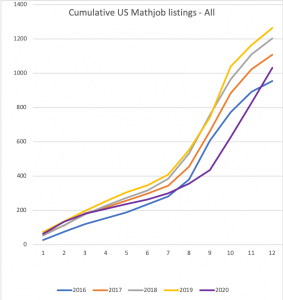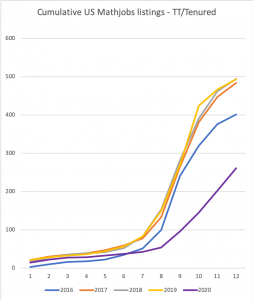Let me start by saying that it’s no news to anyone that the pandemic has affected the academic job market. At the same time, it’s nice to have some data to back up that feeling of doom. Especially for someone like me, who had been on the job market every year between 2015 and 2019 (would not recommend, in case you were wondering), I constantly heard that the job market was tough. But if it’s tough every year, what’s the difference?
In early October 2020, Science reported about a 70% drop in US job postings on their job board, a pretty drastic number. On the other hand, since US math jobs appear primarily on mathjobs.org, and plus the fact that the economy has made an impressive (and frankly, unequal) recovery since the initial crash in March 2020, maybe it’s worth taking a closer look at how the pandemic is affecting math jobs.
So how bad was the 2020 mathjob market?
Going into 2020, the number of graduating PhDs in Mathematics, Statistics, and Biostatistics had been steadily on the rise, a number that the AMS tracks very well.
 On the other hand, the number of jobs posted appeared to be relatively stagnant, between 2013 and 2017, as documented by the AMS again,
On the other hand, the number of jobs posted appeared to be relatively stagnant, between 2013 and 2017, as documented by the AMS again, after which time there was a slow rise in job postings on mathjobs.org, as the graph below shows. When the pandemic hit the US in March 2020, freezing the job market, we saw an initial decrease in job postings (and not to mention a drop in employment which isn’t measured here).
after which time there was a slow rise in job postings on mathjobs.org, as the graph below shows. When the pandemic hit the US in March 2020, freezing the job market, we saw an initial decrease in job postings (and not to mention a drop in employment which isn’t measured here).

Number of all US mathjobs posted in 2020
Later in the year we saw the number of job postings start to pick up, and eventually closing out the year higher than in 2016, but with tenure-track/tenured jobs making a poor recovery. In the end, the total number of jobs posted in 2020 dropped approximately 19% from 2019, whereas the number of tenure-track positions fell by 47%. Austerity measures, as we have learned, correlate only with economic downturns: the economy getting better doesn’t guarantee that stable jobs come back. Retrenchments are still happening in some math departments even as I write.

Number of Tenure-track/Tenured US mathjobs posted in 2020
Taken at face value, we might interpret this to mean a slight respite in employment, but not in terms of job security. A larger than usual proportion of the postings on mathjobs this year were non-tenure-track/tenured. In fact, some PhD students deferred graduating in 2020 in hopes of better job prospects in 2021, but that also means that this year’s job market is going to be a lot more competitive, if we extrapolate from Figure A.2 above. In other words, while in previous years it may be hard to say that the job market was comparatively bad, in 2020 it was definitely so.
Though it’s quite clear that the pandemic is disproportionately affecting people that are not cis, white, straight, male, and financially secure, the actual data on this is much harder to come by (for example, the AMS data does not track race and ethinicity), and when it does exist, it usually only confirms what we already know. And just so it does not go unsaid, since our profession rewards pedigree and papers, the few jobs (especially tenure-track ones) will in all probability go to those who have succeeded mathematically despite the pandemic and political turmoil, besides the usual sources of privilege.
One final note: some might say that job market is going to recover very well in 2021 given the present state of the economy (or the stock market, at least), but history has shown us that what in fact takes place is academia’s shock doctrine, whereby we see job security gradually vanish as adjuncts and contingent faculty continue to replace the ranks of more secure professorships, as happened after the 2008 financial crisis.
What does this mean for us?
Let’s be clear. Our profession has offered no solution, and has in general expressed not a lot of concern regarding the effect of the pandemic nor the calls for equity. Besides a handful of communiqués that echo the “emptiness of administrative statements” from universities, of course. This is especially clear from the recent JMM 2021 that has taken place virtually, more or less with business as usual, in spite of recent events.
That there has been no progress in diversity in the geosciences in the last 40 years raises the same question for the mathematical sciences. Moreover, given that academic prestige has a high premium in faculty hiring networks, so much so that academic hiring was calculated to have a Gini index about 50% more than that of income inequality the US, we can say that the fight for diversity and equity in academia is important because it is demonstrably not diverse and not equal. What’s sadder is that this surprises no one. As one of the co-authors of that study wrote, it’s hard to imagine elite universities supporting major changes because “they benefit from the current system where their students land the most, and best, jobs.”
One main takeaway from all this is that if we do not do anything, things will not get better on their own.
But we have also seen initiatives begin to take place. On top of the “usual” unseen and unpaid work of underrepresented folks in math, we are seeing for example paraDIGMS, SUBgroups, OURF2AM2, the Just Mathematics Collective, the Rethinking Number Theory workshop, all recent grassroots initiatives that seek to make changes along these lines, speaking truth to power and subverting existing hierarchies. Additionally, we have Indigenous Mathematicians, Lathisms, Mathematically Gifted & Black, and Spectra that highlight underrepresented groups in math. Whether or not these will be enough to make up for the attrition that we are currently witnessing remains to be seen. As we all know, academia can be terribly resistant to the change we want to see.
If you have an initiative that you’d like to advertise, please comment below! –
Acknowledgments: Thanks to the folks at mathjobs for the historical data and Snehal Shekatkar for help obtaining newer data.

Thanks for the post. What is the horizontal axis on the mathjobs graphs? Integers 1-12 — is it ?? months??
Yes, months!